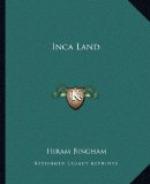Men and boys all wore knitted woolen caps, with ear flaps, which they seldom remove either day or night. On top of these were large felt hats, turned up in front so as to give a bold aspect to their husky wearers. Over their shoulders were heavy woolen ponchos, decorated with bright stripes. Their trousers end abruptly halfway between knee and ankle, a convenient style for herdsmen who have to walk in the long, dewy grasses of the plateau. These “high-water” pantaloons do not look badly when worn with sandals, as is the usual custom; but since this was Sunday all the well-to-do men had put on European boots, which did not come up to the bottom of their trousers and produced a singular effect, hardly likely to become fashionable.
The prosperity of the town was also shown by corrugated iron roofs. Far less picturesque than thatch or tile, they require less attention and give greater satisfaction during the rainy season. They can also be securely bolted to the rafters. On this wind-swept plateau we frequently noticed that a thatched roof was held in place by ropes passed over the house and weights resting on the roof. Sometimes to the peak of a gable are fastened crosses, tiny flags, or the skulls of animals—probably to avert the Evil Eye or bring good luck. Horseshoes do not seem to be in demand. Horses’ skulls, however, are deemed very efficacious.
On the rim of the Titicaca Basin is La Raya. The watershed is so level that it is almost impossible to say whether any particular raindrop will eventually find itself in Lake Titicaca or in the Atlantic Ocean. The water from a spring near the railroad station of Araranca flows definitely to the north. This spring may be said to be one of the sources of the Urubamba River, an important affluent of the Ucayali




